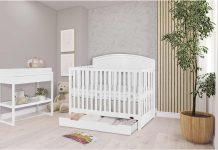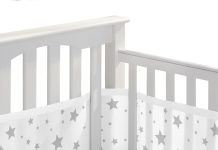Have you ever wondered how to create DIY dividers to split a crib for twins? As parents of twins, we understand the challenge of finding practical solutions that make life easier. In this article, we will share some creative ideas for making your own dividers to create separate spaces within a crib, ensuring both of your little ones can sleep comfortably and safely. Say goodbye to sleepless nights and hello to peaceful rest for both your babies!
Review contents
Materials Needed
To make DIY dividers to split a crib for twins, there are several materials you will need.
Cardboard
Cardboard is a versatile and affordable material that can be easily obtained. It is lightweight, making it easy to work with, and can be cut and shaped to fit your specific needs.
Plywood
Plywood is a sturdy and durable material that provides structural support. It is a good choice if you are looking for a long-lasting solution for dividing your crib.
Acrylic Sheets
Acrylic sheets are a transparent and lightweight option for crib dividers. They allow for visibility while still providing a physical barrier between the babies.
Wooden Boards
Wooden boards are another option for creating dividers. They are sturdy and can be stained or painted to match your nursery decor.
Zip Ties
Zip ties can be used to secure dividers in place. They are easy to use and provide a flexible and adjustable solution.
Methods for DIY Dividers
There are several methods you can use to create DIY dividers for your crib.
Cardboard Divider
A cardboard divider is a simple and affordable option. It can be easily customized to fit your crib and is lightweight, making it easy to handle.
Plywood Divider
A plywood divider offers durability and stability. It provides a more permanent solution and can be easily attached to the crib.
Acrylic Sheet Divider
An acrylic sheet divider is a transparent option that allows for visibility. It provides a physical barrier between the babies while still allowing them to see each other.
Wooden Board Divider
A wooden board divider is a sturdy and customizable option. It can be stained or painted to match your nursery decor and provides a secure barrier between the babies.
Zip Tie Divider
A zip tie divider offers flexibility and adjustability. It can be easily installed and allows for easy removal and repositioning.
Choosing the Right Divider
When choosing the right divider for your crib, there are several factors to consider.
Safety Considerations
Safety should be the top priority when selecting a crib divider. Ensure that the chosen divider is secure and meets safety standards to prevent any accidents or injuries.
Durability
Consider the durability of the divider. Will it withstand regular use? Will it hold up over time? Choose a divider that is made from sturdy materials and built to last.
Cost
Consider the cost of the divider. Determine your budget and choose a divider that fits within your financial constraints. Remember that cheaper options may not always be the most durable or reliable.
Easy Installation
Consider the ease of installation. Some dividers may require complex installation processes, while others may be simpler and more straightforward. Choose a divider that is easy to install and fits well within your DIY skills.
Adaptability
Consider the adaptability of the divider. Will it be able to grow with your babies? Choose a divider that can be easily adjusted or removed as your babies grow and their needs change.
Cardboard Divider
A cardboard divider is a simple and cost-effective solution for splitting a crib for twins. Here is a step-by-step guide to creating a cardboard divider.
Measuring and Cutting the Cardboard
Start by measuring the length and height of your crib. Use these measurements to cut a piece of cardboard to fit the desired size of the divider. Make sure to account for any curves or slopes in the crib.
Securing the Divider
Once you have cut the cardboard to the correct size, use zip ties or adhesive to secure the divider to the crib. Make sure it is tightly secured to prevent any movement or shifting.
Decorating the Cardboard
If desired, you can decorate the cardboard divider to match your nursery decor. Use non-toxic paint or adhesive decorations to add a personal touch.
Plywood Divider
A plywood divider provides a more permanent and sturdy solution for splitting a crib for twins. Here is a step-by-step guide to creating a plywood divider.
Measuring and Cutting the Plywood
Measure the length and height of your crib and use these measurements to cut a piece of plywood to fit the desired size of the divider. Consider adding a few inches of extra height to ensure a secure fit.
Attaching the Plywood to the Crib
Using screws or brackets, attach the plywood to the sides of the crib. Make sure the attachment points are secure and ensure there are no sharp edges or protruding screws that could pose a safety hazard.
Finishing the Plywood
Sand down any rough edges and surfaces of the plywood divider to prevent splinters. You can also choose to paint or stain the plywood to match your nursery decor.
Acrylic Sheet Divider
An acrylic sheet divider provides a transparent barrier between the babies while still allowing for visibility. Here is a step-by-step guide to creating an acrylic sheet divider.
Measuring and Cutting the Acrylic Sheet
Measure the length and height of your crib and use these measurements to cut an acrylic sheet to fit the desired size of the divider. Make sure to use the appropriate tools and techniques for cutting acrylic.
Attaching the Acrylic Sheet to the Crib
Using brackets or adhesive, secure the acrylic sheet to the sides of the crib. Ensure that the attachment points are secure and that there are no sharp edges or corners that could pose a safety hazard.
Adding Reinforcements
To enhance stability, you can add reinforcements such as wooden dowels or additional brackets. This will help prevent any bending or bowing of the acrylic sheet.
Wooden Board Divider
A wooden board divider provides a sturdy and customizable solution for splitting a crib for twins. Here is a step-by-step guide to creating a wooden board divider.
Choosing and Cutting the Wooden Boards
Choose wooden boards that are the appropriate height and thickness for your crib. Cut the boards to the desired length and width of the divider, making sure to account for any slopes or curves in the crib.
Securing the Boards to the Crib
Using screws or brackets, secure the wooden boards to the sides of the crib. Make sure the attachment points are secure and that there are no sharp edges or protruding screws that could pose a safety hazard.
Adding a Finish
You can choose to stain or paint the wooden boards to match your nursery decor. Apply a non-toxic finish to protect the wood and prevent any splinters.
Zip Tie Divider
A zip tie divider offers flexibility and adjustability. Here is a step-by-step guide to creating a zip tie divider.
Creating and Cutting the Zip Tie Grid
Start by creating a grid pattern with zip ties. Cut the zip ties to the desired length and position them vertically and horizontally to create a secure grid.
Attaching the Grid to the Crib
Secure the zip tie grid to the sides of the crib using zip ties or adhesive. Make sure the attachment points are tight and secure.
Enhancing Stability
To enhance stability, consider adding additional zip ties or reinforcing the grid with wooden dowels. This will help prevent any movement or shifting of the divider.
Tips and Considerations
When using DIY dividers to split a crib for twins, there are a few additional tips and considerations to keep in mind.
Ensuring Proper Ventilation
Make sure that your chosen divider allows for proper airflow and ventilation in the crib. This will help maintain a comfortable and safe sleeping environment for the babies.
Preventing Entanglement Hazards
Regularly inspect the dividers to ensure that there are no loose or dangling parts that could pose an entanglement hazard. Trim any excess materials and secure all attachment points.
Regular Monitoring and Adjustments
Monitor the dividers regularly to ensure they remain secure and in good condition. Make any necessary adjustments or repairs as needed to maintain the safety and effectiveness of the dividers.
Practicality for Twins
Consider the practicality of the dividers for twins. Will they provide enough space for each baby to sleep comfortably? Ensure that the dividers accommodate the needs of both babies.
Conclusion
Creating DIY dividers to split a crib for twins can provide a cost-effective and customized solution. Whether you choose a cardboard divider, plywood divider, acrylic sheet divider, wooden board divider, or zip tie divider, it is important to consider safety, durability, cost, ease of installation, and adaptability when making your decision. By following the step-by-step guides and keeping the provided tips and considerations in mind, you can create a safe and functional crib divider for your twins. Remember to regularly monitor the dividers and make any necessary adjustments to ensure the comfort and safety of your babies.






























